Here was the call to action:
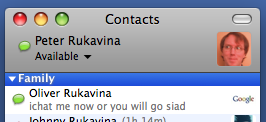
And here was the father and son iChat that resulted:
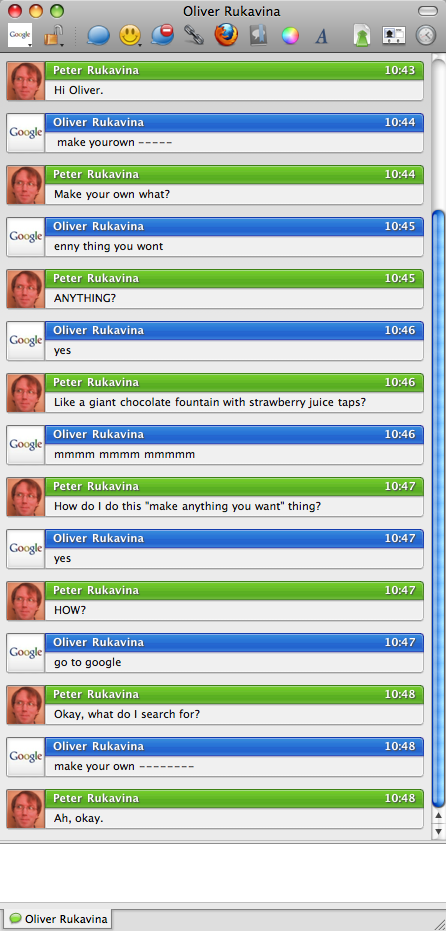
The amazing this is that it’s true: go to Google and search for “make your own” and you can make anything. I am a proud DIY father.
I’m never one to miss a federal government open house. Perhaps it’s due to my fond memories of open houses at the Canada Centre for Inland Waters where my father worked when I was a kid. So when the signs went up earlier this summer for the 100th anniversary open house at the Experimental Farm, I made sure to note the date and plan a day around it.
[[Catherine]] is still recovering from the GST Centre open house in Summerside a decade ago – somehow she wasn’t as entranced as I was by the amazing machines that could slit open envelopes – and so it was to be a father-and-son outing (as [[Oliver]] added later: what does Catherine need with a farm open house, having grown up on one).
The Experimental Farm, while founded in Charlottetown in 1909, has been shifting its research operations to Harrington, 30 minutes out of town toward the north shore, in recent years, so the focus of the open house was not in Charlottetown but out at the satellite operation. Although you could drive out to Harrington, Agriculture Canada also chartered double-decker buses to take people from the farm in Charlottetown out to Harrington, a rare and brilliant move that let a lot of people without cars make a trip they wouldn’t have been able to otherwise (while the double-decker buses are intriguing, they are not perhaps the least-polluting people-carrying vehicles on Island roads and I hold out hopes for the 125th anniversary that we downtowners will be transported out on pollution-free hover-chariots).
Once we got to Harrington there were myriad things to see and do. There was a free barbeque (with uncommonly tasty 100th anniversary cake), kids activities, wagon rides, a hay maze, bugs and slugs to look at, and innumerable scientific posters on the various ills that can afflict Island crops. There were even competing costumed giant potatoes wandering about battling for the affections of the young.
Along the way I actually ended up learning a lot about the history of the Experimental Farm, aided, in no small way, by a well-crafted introductory video that was shown in Charlottetown while we waited for the bus.
Although the 100th anniversary open house only comes around once, there was promise of an every-second-year open house on a smaller scale, so be sure to look out for the signs in 2011: highly recommended.
In a profile of Nora Ephron in a recent issue of The New Yorker, Ariel Levy wrote about the challenge of writing about people you know:
Ephron’s pieces were vivid and cunning and crackling with her personality; she began an eviscerating profile of Dorothy Schiff, the publisher of the New York Post, where she had worked for a time, with the words “I feel bad about what I’m going to do here.”
While I make no claim to words of vivid crackle, and while I’ve no plans to eviscerate anyone today, I do recognize the challenge of writing inside a closed system. Like the closed system that is Prince Edward Island.
Take Patrick Ledwell for example. Here is an incomplete list of the connections I have to Patrick Ledwell:
- His sister Jane took on the job of Executive Director of the L.M. Montgomery Land Trust after I held it.
- I have a painting by Jane’s partner Stephen B. MacInnis hanging on the wall of my bedroom.
- Okeedokee, a company I co-founded, once employed Patrick’s cousin Andrea Ledwell.
- Patrick’s brother Thomas Ledwell used to work at CBC Montreal with my brother [[Steve]].
- We bought our current house from realtor Paula Willis. At one point (and maybe to this day) there was a yearly tradition that say the Willis children play the Ledwell children in a basketball game over Christmas.
- Patrick and I are both contractors on the Island Lives project for UPEI.
- Patrick works in an office about 40 feet from my own office.
- I knew and respected Patrick’s late father Frank Ledwell.
All of which I relate simply to suggest that, evisceration or no, writing a review of The New Potato-Time Review, a comedy and music show by Patrick Ledwell (who I will somewhat awkwardly refer to as “Ledwell” in what’s to come) and Tanya Davis, has implications.
That all said, let me get to the punchline: there are some great moments of comedy in the Review, and Tanya Davis was an unexpected delight, and if you want a night of high-quality entertainment that will leave you feeling good about the world, you owe it to yourself to get out to Victoria-by-the-Sea before the show closes on August 2nd.
Which is not to suggest that the show is without its rough patches.
The central conceit — old-school stand-up comic sharing the stage with a singer of pithy insightful ballads about death and belonging — is somewhat precarious. Mostly it works, but it falls apart when comic and singer work outside their comfort zones, when the comic sings or the singer tells jokes. I think particularly of the last sketch, an extended singalong on Island name pronunciation (Dalziel, Gaudet, Doiron, etc.) that seems more like an obligatory hat-tip to the Wayne and Shuster review format than something either is particularly passionate about. The opening duologue, a sort of poetic back-and-forth on Island themes, suffers from the same uncomfortable feeling, especially as the styles of the two performers is so different. Imagine something like George Carlin jamming with Victoria Williams.
So it’s fine — great even — that Ledwell and Davis share the stage. Just not, perhaps, at the same time.
When they’re on their own, each is at their best when the material is closest to their gut.
For Ledwell this comes during a monologue about the joys and frustrations of growing up in a large and chaotic Island family: his glassy eyes were a testament to the sincerity of the material, and it was only here that he really broke through the fourth wall and established a true sense of himself with the audience. For Davis it came with a temporary costume change and a monologue cum song on growing up weird on PEI. The air was thick with things that need to be expressed more often in this insular place, and with the pierce emerged the central theme of the show (such as there is a central theme): the Island is a strange, fitful and mysterious place that can enliven and destroy, entertain and confuse, and is perhaps, in its small, isolated, interconnected way, unique in the world.
Of course the show is mostly not so, um, serious. Mostly it’s quite funny. And sometimes it’s roll-on-the-floor funny.
The comedy of the show is built around Ledwell’s reactions to rear-projected slides: artworks, faux PowerPoint slides, Jay Leno-style clippings from local newspapers. The visuals are well constructed, and Ledwell’s timing is crackerjack and takes material that would just be passing funny — “Diary Bar for Sale,” “House for Sale: 14 Dump Road” — and takes it to another level. Some of the material comes from the standard Island comedian/storyteller playbook — “here” vs. “from away”, growing up in hand-me-downs, and the like — but the approach is more contemporary than the usual “I remember old Mrs. Gallant from the Horne Cross Road…” and while it would be a stretch to say there’s anything of an “urban sensibility,” Ledwell’s comedy is pleasantly absent of an “old timey” feel.
Tanya Davis, while treading into comedy from time to time, shoulders the responsibility for the mournful part of the bill. Or perhaps mournful is not the right word. She does sing songs that are considerably more packed with ideas that the usual balladeer, though. From her song Gorgeous Morning, for example, a rumination on taking a different path in life, is the lyric:
and it makes for bad digestion when you are crying onto your toast
and if that’s how breakfast goes you know you’re in for it
but i had no intentions then, go to work and come back home
my feet heavy and slow every minute of it
In the same way the Ledwell freshens the comedy tradition, Davis sings songs that shed a new and valuable light on the Prince Edward Island experience. She is a talented singer, a capable guitar player, and has an understated stage presence that she uses to good effect.
You wouldn’t think that the counterpoint of Ledwell’s “of course they’d never heard of seat belts when we were growing up” and Davis’ songs about graveyards would work, but, somehow, it does, and the audience, which included everyone from young rockers to community stalwarts, responded well to most of it.
When so much of Prince Edward Island’s summertime theatrical entertainment is tired remixes on the Anne theme, it’s exciting to see contemporary material presented by talented and thoughtful artists, and I expect great things from both Ledwell and Davis in years to come.
The New Potato-Time Review runs through August 2nd at the Victoria Playhouse in Victoria-by-the-Sea, Prince Edward Island. I highly recommend you sample the delights of Island Chocolates and The Landmark Café before the show.
Back in June I found myself standing on platform #5 of the train station in Malmö, Sweden waiting for the 8:02 a.m. train to Copenhagen with [[Catherine]], [[Luisa]] and [[Olle]] when an intriguing looking man approached us on the platform. He was intriguing mostly because he was carrying a substantial looking metal briefcase that was held together with green gaffer’s tape. This man turned out to be known to Olle and Luisa: he was David Sjunnesson, an interaction designer, hacker, and Arduino propagator headed to the same [[reboot]] conference that we were.
Over the next few days I got to know David a little — we ended up sharing the train from Malmö more than once — and on the final afternoon of reboot I was in the room as David skillfully facilitated a Full Body Arduino workshop.
When I got home to Canada I started to follow the RSS feed of 1scale1, the Malmö-based “critical research studio” that David is a part of, and it’s through the 1scale1 blog that I came to learn, this afternoon, of a wonderful new book that comes out of 1scale1 called Open Softwear: Fashionable Prototyping and Wearable Computing using the Arduino.
The book is wonderful on several levels. First, the subject matter hits at the heart of my current obsession with physical computing and DIY, second it’s well-written and lovingly designed, and third, and perhaps most interesting, it has been published with a Creative Commons Attribution-Noncommercial-Share Alike 2.5 Generic license.
This means that, among other things, I was free to grab the PDF of the book and print up a copy for myself. This turned out to be an interesting and fulfilling exercise in its own right.
Sending PDF files to local printers here in Charlottetown has always been inconvenient or expensive or both, so I was initially reluctant to go through the hassle. Before giving up though, I decided to try Staples (Staples is a Canadian big-box office supply chain). While I’d never received particularly good face-to-face service from their print shop, I was interested in their purported ability to accept print orders online, and so I gave their system a try.
Somewhat to my surprise — we do, after all, live in a world where almost no company gets online service delivery right — the experience was almost completely positive: quick, easy, and inexpensive.
I simply created an account on the Staples Copy and Print website, uploaded the PDF of Open Softwear that I’d downloaded, and then selected my print options: double sided on white 30% recycled 20 lb. paper with a white 65lb. cover, coil bound. As I played with different options the price was updated in real time (I could have printed it for as little as $8.00 with no cover or binding), and when I was done I had this order:
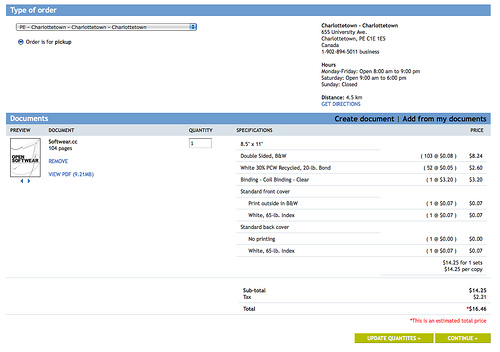
The entire ordering exercise took about 10 minutes. About 15 minutes after I placed the order I got a call from the local Staples telling me that they couldn’t coil-bind the order, but they could cerlox-bind it, and I gave them the go ahead.
Two hours later I was at home, checked my email, and found a message from Staples:
Your print job #513589 is complete and ready for pick up.
I hopped in the car and 10 minutes and $17.00 later the printed and bound book was in my hands. They did a nice job: the cover is thick and solid-feeling, the binding holds it all together well, and the inside, although only in black and white and not its native full-colour glory, is perfectly acceptable:
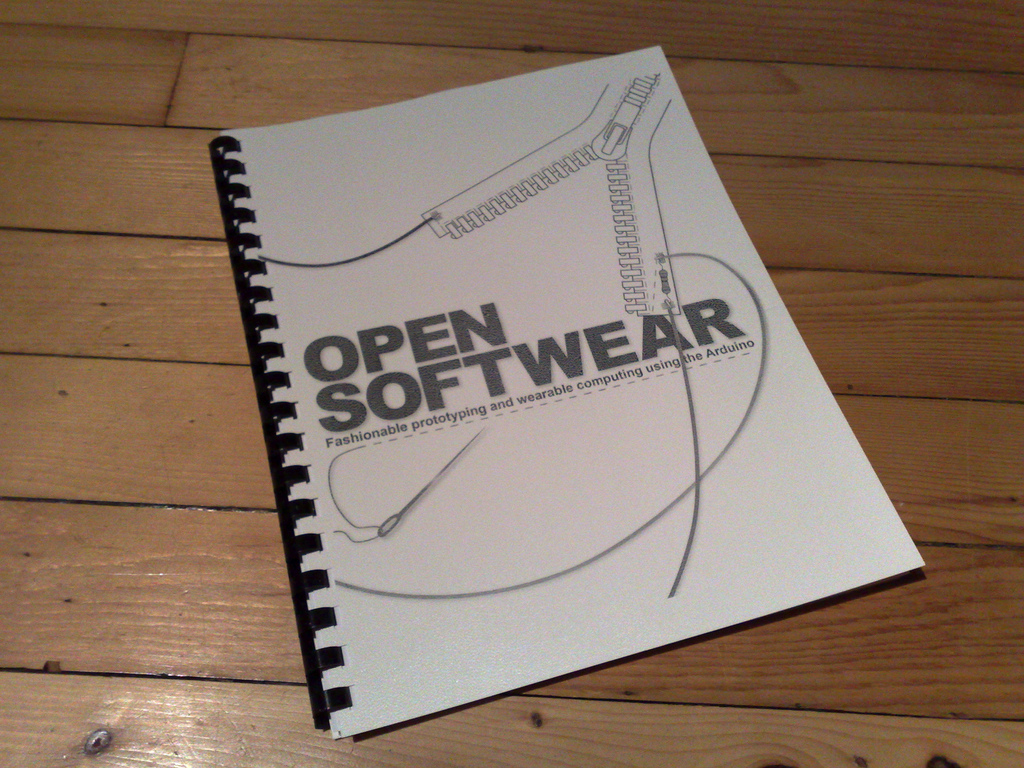
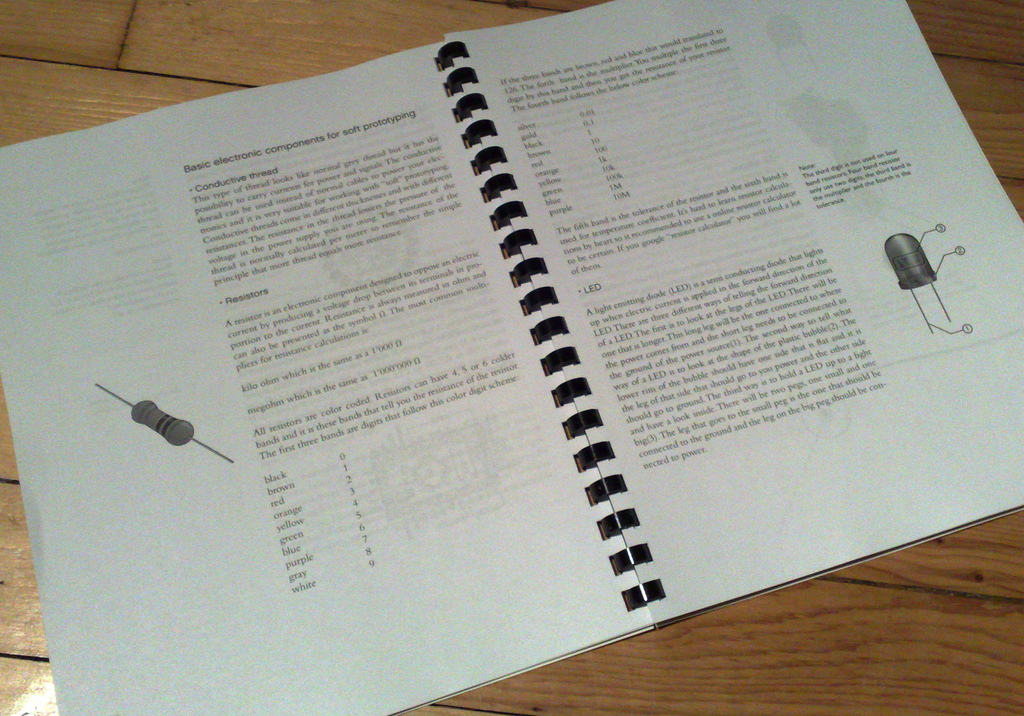
This was all deeply satisfying to me.
While on one level this is a simple “big deal: you got a PDF file printed” story, there is a whole other layer that says a lot about the future of publishing:
- The “marketing” for the book consists of a blog post and a simple website — I learned about the book via RSS. No agents, publishers, wholesalers, bookstores or other third-parties were involved.
- While the book’s subject matter scratches all the right itches for me, the “wearable computing” market is admittedly quite small, and I might be the only person interested in the book in my neighbourhood: but that doesn’t matter anymore.
- While I’d experienced the wonders of print-on-demand before, the “on demand” with something like Lulu.com involves a time lag of weeks for the printing to happen; this experience was much closer to the Utopian “desktop book-printing machine” we’ve long heard about.
- The Creative Commons license that made this all possible is such a sensible way to spread ideas: sure, the authors have nothing but my gratitude (and this blog-post-of-thanks), but their material is in my hands now, and now I am part of the propagation machine.
So, to authors Tony Olsson, David Gaetano, Jonas Odhner, and Samson Wiklund: thank you for your ideas, and your openness in sharing them. To David Sjunnesson, thanks for starting me down the path. And to everyone else — or at least those of you with a wearable computing fetish — go print yourself a copy of the book too!
Now, off to read my new book and start stitching together my location aware laser-guided Oxford-cloth button-down shirt.
Earlier this month I blogged about some work I’d done to grab and parse my credit union statements in an effort to learn more about my spending habits.
A few days later I received a helpful and supportive email from the Director of Product Management at Central 1 Credit Union, the company that develops and manages the MemberDirect service that powers my local credit union’s online banking system (this is sort of like blogging about a problem with your MacBook and having Jonathan Ive give you a call).
Not only did he encourage my experimenting, but he also suggested that we speak on the phone so he could answer some of my technical questions and discuss some of the broader ideas of helping credit union members learn more about our spending.
We’ve just had that call and it was very helpful. Among the things I learned:
- Central 1 Credit Union is a new company resulting from the merger of the provincial Credit Union centrals in British Columbia and Ontario.
- In Atlantic Canada there’s a central organization called “League Data” that provides the technology used by my Credit Union itself – the actual “how much money is in Peter’s account” stuff; the MemberDirect service communicates with League Data’s systems using a message specification.
- MemberDirect can only deliver to me data that League Data’s systems deliver to it. So, for example, the MemberDirect system supports delivery of full “metadata” for both current and archival transactions, but it appears that League Data only provides MemberDirect for full metadata for the current month’s transactions. This is thus a League Data issue, not a MemberDirect issue.
- The message specification used for communication between MemberDirect and League Data doesn’t support any greater level of time granularity that a single day: in other words, transactions can only be date-stamped, not time-stamped (which limits my pie-in-the-sky “geolocation through transaction analysis” project somewhat…).
My ideas about providing spending information to members through MemberDirect were also well-received, and we’ve agreed to keep talking about this.
Just as the call was ending I mentioned that I’d enjoyed watching the evolution of MemberDirect over the years, and appreciated the fact that its technology decisions are, unlike the systems of banks, 100% member-driven. As evidence of this I noted a feature that was introduced recently that saw a “Make this my default account to pay bills from” checkbox added to the bill payment screen. It’s a simply feature, but a very useful one that’s saved me from a lot of frustration (through “you need to select an account” error messages). As it turns, the person whose shephherded this feature into the system was also in on the call, so I got a chance to thank him personally for the help.
Taken together this is all an illustration of what’s so great about the Credit Union movement: Credit Unions are transparent, member-driven, and excel at the kind of personal customer service that is completely beyond the range of banks. It’s inconceivable to me that anyone involved in technology planning at a bank would contact me if I blogged about their systems; even if they wanted to, they would likely not be allowed to. Within the Credit Union movement, apparently, talking with users is actually encouraged. Go figure.
I was a Metro Credit Union proud member today, and I’m looking forward to taking this project further.
Not Every Child Is Secretly a Genius, an essay in The Chronicle of Higher Education by Chris Ferguson, is an excellent bubble-bursting treatise on the “multiple intelligences” education theories of Howard Gardner that have been so much in vogue over the last 20 years as to have become accepted as truth within the educational establishment.
As much as I’m not sure that Ferguson is completely right, I’ve never been altogether sure Gardner’s theories represented more than a hope that our minds work differently than they do. And this is the crux of Ferguson’s argument about multiple intgelligences:
It’s “cool,” to start with: The list-like format has great attraction for introductory psychology and education classes. It also seems to jibe well with the common observation that individuals have particular talents. More important, especially for education, it implicitly (although perhaps unintentionally on Gardner’s part) promises that each child has strengths as well as weaknesses. With eight separate intelligences, the odds seem good that every child will be intelligent in one of those realms. After all, it’s not called the theory of multiple stupidities.
It would be wonderful to live in a world where we were all equally capable of achieving greatness in something. Indeed I’d say that’s the bedrock of my educational philosophy to date, and a good part of the underpinning of how I approach the world. But it’s good to be reminded that it’s a relatively recent model for intelligence, and one that might be based on a Utopian dream more than a practical reality. As Ferguson writes:
That is the root of the matter. Too many people have chosen to believe in what they wish to be true rather than in what is true. In the main, the motive is a pure one: to see every child as having equal potential, or at the very least some potential. Intelligence is a fundamentally meritocratic construct. There are winners and there are losers. A relative doofus may live a comfortable life so long as his or her parents are wealthy. However, clawing one’s own way out of abject poverty is best achieved with a healthy dose of both motivation and “g.”
As much as it pains me, I’ve a feeling Ferguson might be right about all this, and I’m left with the question: what to do about the doofuses?
(Oh, and just to be clear: my child is secretly a genius)
As proof that there is an organization for everyone: Canadian Association of Ukrainians from Former Yugoslavia. Thanks to my father for the pointer.
In my old homebrew blogging system, I built in a function that let me enter references to articles in the Rukapedia but just surrounding an entry’s title in double square brackets: when the post was displayed to the public, the link would automagically get rewritten to become an HTML hyperlink.
I didn’t want to have to go back and edit these posts and manually insert HTML links for Drupal, so I solved the problem by leaving this as they were and writing a simple Drupal Input Format filter called wikilinks. It turned out to be really easy to do this. Here’s how.
First, I created a new directory under the sites/all/modules directory in my Drupal installation called wikilinks. Inside that directory I created two files: wikilinks.info and wikilinks.module.
In wikilinks.info I put the following information describing the module:
name = Wiki Links Filter description = A filter to convert wiki links into HTML links to the wiki. core = 6.x
In wikilinks.module I put the following PHP code:
<?php
// $Id$
function wikilinks_filter($op, $delta = 0, $format = -1, $text = '', $cache_id = 0) {
switch ($op) {
case 'list':
return array(0 => t('Wiki links'));
case 'description':
return t('Converts old-style wiki links to HTML hrefs to wiki.ruk.ca.');
case 'prepare':
return $text;
case "process":
$text = preg_replace("/\[\[(.*?)\]\]/","<a href=\"http://wiki.ruk.ca/wiki/$1\">$1</a>",$text);
$text = str_replace("[indent]","",$text);
return $text;
default:
return $text;
}
}
The heavy lifting is done in this line:
$text = preg_replace("/\[\[(.*?)\]\]/","<a href=\"http://wiki.ruk.ca/wiki/$1\">$1</a>",$text);
The text that gets passed to the filter gets scanned and all instances of two square brackets followed by any number of characters followed by another two square brackes gets replaced by a hyperlink to http://wiki.ruk.ca/wiki/ followed by the term that was surrounded.
Once these two files were in place, I just visited Administer > Site Building > Modules, added the Wiki Links module, and then Administer > Site Configuration > Input Formats and clicked the Configure links for the “Full HTML” input format and checked the box beside “Wiki Links.”
Once all this was in place, all the old-style encoded links to the Rukapedia worked fine, with no conversion needed.
 I am
I am